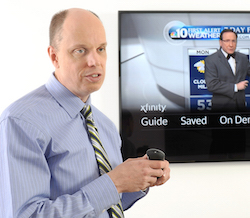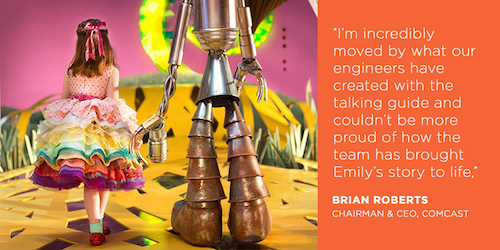By Joan Leotta

Tom Wlodkowski, Comcast Vice President of Accessibility
Almost 200 years ago, Braille opened up the world of written communication to people who cannot see. Now, Comcast has developed a solution that allows blind people to enjoy all of the action, not just the dialogue, in any program on television. The new feature also allows users to hear descriptions of menu options usually only presented as text on the screen. Just as Braille opened up the universe of written stories, Comcast Xfinity’s X1 service unlocks the world of television entertainment in new ways for people with visual disabilities.
Tom Wlodkowski, Comcast’s VP of Accessibility, knows that technological advances have the power to help people with disabilities be full participants in all activities of everyday living. “As someone who was born blind, I always thought of technology as a great equalizer,” he explains. “And when I joined Comcast to focus on product accessibility, I was excited to explore how our services could open new doors to independence. I’ve been here close to three years now and I feel like we’ve made progress on a number of fronts. But watching this effort come to fruition, and hearing how people are reacting, really leaves me speechless.”
In a recent Comcast press release, customer and product beta tester Amy Ruell echoed these sentiments. “TV is such an important and integral part of the fabric of our culture,” she believes, “that to be excluded from that experience in any way makes it more difficult for blind people to participate fully in society.”
How It Works
Comcast’s revolutionary X1 service is the first to provide voice guidance through the ever-more-complex menus involved in TV viewing and recording. All Xfinity X1 customers across the country can activate the talking guide on their existing boxes by tapping the “A” button twice on their remote controls. The feature can also be turned on via the Accessibility Settings within the main menu.
“The talking guide speaks what’s on the screen as the viewer navigates the Guide, Saved, On Demand, and Settings sections of X1,” Wlodkowski explains. In addition to vocally communicating menu items, the service relays information such as individual program descriptions and ratings from Common Sense Media and Rotten Tomatoes to help viewers decide what programming they might enjoy. “Future versions of the feature will include functionality within the Search section and additional personalization settings like rate of speech,” Wlodkowski continues.
A video previewing the new service is now available at the Comcast website.
Development of the Talking Guide
Wlodkowski notes that “about 19 million U.S. households have at least one member with a disability and, according to the U.S. Census, there are 8.1 million people with a visual disability.” These numbers reveal not only buyer potential but, more significantly, a segment of the US population who are often not able to join in the national conversation that is TV viewing.
A few years ago, Comcast set out to solve that problem at one of its Lab Weeks: employee-led innovation workshops. As Wlodkowski reports, “In the fall of 2012, a team of developers got together in Philadelphia and brainstormed a new X1 feature for an upcoming Lab Week centered on the theme of accessibility. They called it Text to Speech and, inspired by the notion that there should be more than one way for customers to interact with their TV interface and discover what’s on, the idea set the stage for what would become the industry’s first voice-enabled television user interface. Around the same time that year, I took the helm as the Vice President of Accessibility for Comcast to focus on the usability of our products and services by people with disabilities.”
Emily
Recognizing the value such a service could provide to potential television audiences, Comcast chose to highlight the talking guide through a commercial that aired during the Oscars. The ad featured a seven-year-old girl named Emily who has been blind since birth. Through the ad, viewers can experience what Emily “sees” when she enjoys her favorite movie, The Wizard of Oz. They also are exposed to the reality that people who cannot see also want access to the infinite stories available through TV.
Wlodkowski relates, “We’re hoping to spark an even bigger conversation about how people with disabilities enjoy entertainment through a national campaign called Emily’s Oz.” Taking Emily’s impressions of the classic film, a documentary crew has recreated the story and characters as Emily envisions them. “But the cool part,” Wlodkowski emphasizes, “is how we bring her vision to life in a way she’s never experienced before. It’s an adorable and inspiring outcome — not because Emily happens to be blind, but rather because she is an independent, imaginative and charming young girl whose creative mind is infectious.”
Using the time during the Oscars to introduce the talking guide service not only helped spark awareness of the entertainment possibilities for blind people. It also increased the determination to do more on the part of Comcast’s staff. Wlodkowski asserts, “The work that went into telling Emily’s story has really galvanized my team and encouraged us all to pursue even bolder things.”

Comcast’s Commitment to Accessibility
The voice guidance system is just the latest in a series of innovations created in the Comcast Accessibility Lab. “From expanding the number of On-Demand movies and shows that include video description to helping those with a disability navigate their smart home and the Internet of Things, we’re still just scratching the surface of what’s possible in the accessibility space,” Wlodkowski reports. Check out the full range of current and future accessible produce from Comast: Leveling the Playing Field with Products for Everyone.
“The talking guide is as much about usability as it is about accessibility,” he continues. “We think about accessibility from the design of a product all the way through production, and this feature is the result of years of work by our team, including customer research, focus groups and industry partnerships. For people like me who are blind, this new interface opens up a whole new world of options for watching TV.”
Comcast has long been active in providing solutions that make it more enjoyable for people with a variety of disabilities to enjoy broadcast entertainment. In addition to voice guidance and one-touch access to closed captioning, Comcast has created an online help and support resource for Xfinity customers looking for information about accessibility-related topics. The webpage includes an overview of accessibility products and services, support for third-party assistive devices, information related to Braille or large-print bills and the ability to connect with accessibility support specialists.
The company has a service center specifically dedicated to customers with disabilities. Comcast’s Accessibility Center of Excellence, based in Pensacola, Florida, houses a team of specially-trained agents who handle about 10,000 calls each month.
Comcast plans to collaborate with service organizations and nonprofits to create awareness in the disability community, not only to promote the voice guidance system but also to highlight other accessibility features that offer more inclusive entertainment experiences. “Comcast’s commitment to accessibility is encouraging,” beta tester Ruell contends, “because it means there will be tremendous progress in developing technology that is universally accessible.”
Article edited by Mary-Louise Piner.